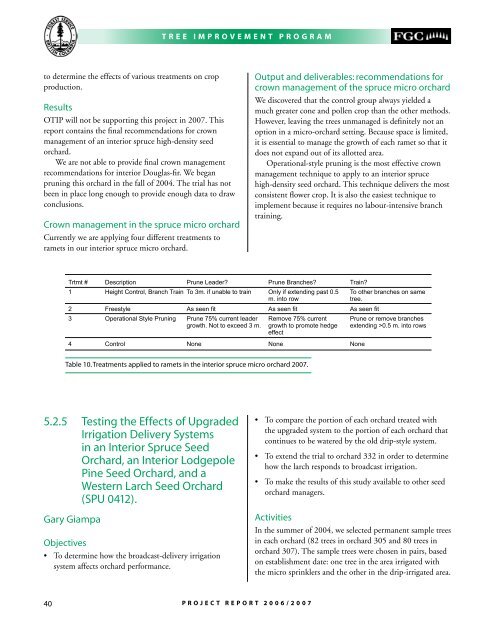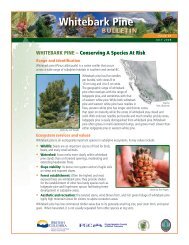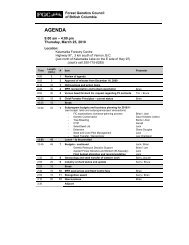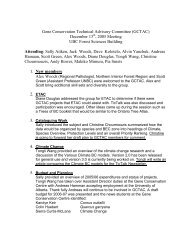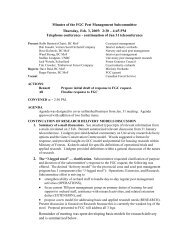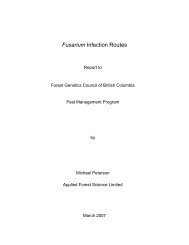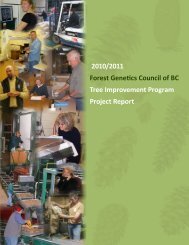Tree Improvement Program Project Report 2006 / 2007
Tree Improvement Program Project Report 2006 / 2007
Tree Improvement Program Project Report 2006 / 2007
Create successful ePaper yourself
Turn your PDF publications into a flip-book with our unique Google optimized e-Paper software.
to determine the effects of various treatments on crop<br />
production.<br />
Results<br />
OTIP will not be supporting this project in <strong>2007</strong>. This<br />
report contains the final recommendations for crown<br />
management of an interior spruce high-density seed<br />
orchard.<br />
We are not able to provide final crown management<br />
recommendations for interior Douglas-fir. We began<br />
pruning this orchard in the fall of 2004. The trial has not<br />
been in place long enough to provide enough data to draw<br />
conclusions.<br />
Crown management n the spruce m cro orchard<br />
Currently we are applying four different treatments to<br />
ramets in our interior spruce micro orchard.<br />
0<br />
T R E E I M P R O V E M E N T P R O G R A M<br />
Figure xx. Treatments applied to ramets in the interior spruce micro orchard <strong>2007</strong><br />
P R O J E C T R E P O R T 2 0 0 6 / 2 0 0 7<br />
Output and del verables: recommendat ons for<br />
crown management of the spruce m cro orchard<br />
We discovered that the control group always yielded a<br />
much greater cone and pollen crop than the other methods.<br />
However, leaving the trees unmanaged is definitely not an<br />
option in a micro-orchard setting. Because space is limited,<br />
it is essential to manage the growth of each ramet so that it<br />
does not expand out of its allotted area.<br />
Operational-style pruning is the most effective crown<br />
management technique to apply to an interior spruce<br />
high-density seed orchard. This technique delivers the most<br />
consistent flower crop. It is also the easiest technique to<br />
implement because it requires no labour-intensive branch<br />
training.<br />
Trtmt # Description Prune Leader? Prune Branches? Train?<br />
1 Height Control, Branch Train To 3m. if unable to train Only if extending past 0.5<br />
m. into row<br />
2 Freestyle As seen fit As seen fit As seen fit<br />
3 Operational Style Pruning Prune 75% current leader<br />
growth. Not to exceed 3 m.<br />
Remove 75% current<br />
growth to promote hedge<br />
effect<br />
4 Control None None None<br />
Table 10. Treatments appl ed to ramets n the nter or spruce m cro orchard <strong>2007</strong>.<br />
.2. Test ng the Effects of Upgraded<br />
Irr gat on Del very Systems<br />
n an Inter or Spruce Seed<br />
Orchard, an Inter or Lodgepole<br />
P ne Seed Orchard, and a<br />
Western Larch Seed Orchard<br />
(SPU 0 12).<br />
Gary G ampa<br />
Object ves<br />
• To determine how the broadcast-delivery irrigation<br />
system affects orchard performance.<br />
To other branches on same<br />
tree.<br />
Prune or remove branches<br />
extending >0.5 m. into rows<br />
• To compare the portion of each orchard treated with<br />
the upgraded system to the portion of each orchard that<br />
continues to be watered by the old drip-style system.<br />
• To extend the trial to orchard 332 in order to determine<br />
how the larch responds to broadcast irrigation.<br />
• To make the results of this study available to other seed<br />
orchard managers.<br />
Act v t es<br />
In the summer of 2004, we selected permanent sample trees<br />
in each orchard (82 trees in orchard 305 and 80 trees in<br />
orchard 307). The sample trees were chosen in pairs, based<br />
on establishment date: one tree in the area irrigated with<br />
the micro sprinklers and the other in the drip-irrigated area.


